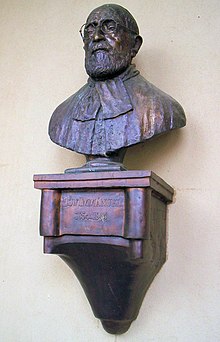Immanuel Loew
Immanuel Löw (born January 20, 1854 in Szeged ; died July 19, 1944 in Budapest ) was a Hungarian rabbi and scholar.
Life
Immanuel Löw, son of Leopold Löw , took over the office of rabbi in the southeast Hungarian city of Szeged three years after his father's death in 1878. 1889-1900 he published the collected writings of his father in five volumes. He studied at the University for the Science of Judaism in Berlin and at the University of Leipzig . For the New Synagogue in Szeged , built in 1903 (architect: Lipót Baumhorn ), he contributed the plans and designs of the glass windows . During the White Terror and the counter-revolution in Hungary from 1920 to 1921, Löw was accused of making anti-subversive statements against Reich Administrator Horthy and was therefore imprisoned for 13 months. There he worked on his four-volume work Die Flora der Juden . From 1927 he represented the “neology” communities (somewhat similar to Conservative Judaism ) in the upper house of the Hungarian parliament and was also a member of the Jewish Agency . Two months after his 90th birthday, the German occupation of Hungary took place . Löw was first held in a brick factory in the ghetto and then sent to certain death on a deportation train . In Budapest, however, he was liberated by Zionist workers and died that same year in the Hungarian capital.
plant
Like his father, Löw was a great preacher in the Hungarian language, and between 1900 and 1939 hundreds of his speeches were published in four volumes. In 1883 he published a Hungarian prayer book for women and also translated the Song of Songs and some psalms into Hungarian.
Löw's fame as a scholar is mainly based on his pioneering work in the field of Talmudic and rabbinical lexicography and the study of plant names. This particular interest is already evident in his doctoral thesis Aramaic Plant Names ( 1879) as well as in Meleagros from Gedera and the Flora Aramaea (1883). Half a century later this research found its culmination in the four-volume Flora der Juden (1924–1934). Löw systematically researched the basics of plant terminology in various periods of the Hebrew and Aramaic languages , mastered the latest scientific methods in the field, familiarized himself with literary sources of plant names and made careful use of manuscript material . With the help of Semitic languages , especially Syriac , he contributed to the clarification of etymologies . His flora of the Jews brought the phenological, the biblical and the botanical aspects to a common denominator, whereby he mainly kept to the original Hebrew names; the book is still considered to be one of the major works on biblical botany.
In the field of fauna as well as minerals , he published further articles in scholarly publications. However, his manuscript Minerals of the Jews was lost in the tragic events of 1944. Part of his literary estate went to the Jewish National and University Library in Jerusalem , and another part to the Budapest Rabbinical Seminary . In 1969 Fauna and Minerals of the Jews was published with an introduction by Alexander Scheiber , the director of the Budapest Rabbinical Seminary.
literature
- Franz Menges: Loew, Immanuel. In: New German Biography (NDB). Volume 15, Duncker & Humblot, Berlin 1987, ISBN 3-428-00196-6 , p. 71 f. ( Digitized version ).
- Benda: Löw Immánuel. In: Austrian Biographical Lexicon 1815–1950 (ÖBL). Volume 5, Verlag der Österreichischen Akademie der Wissenschaften, Vienna 1972, p. 283.
- Loew, Immanuel , in: Encyclopaedia Judaica , Volume 11, 1972, Col. 442-444
Web links
- Literature by and about Immanuel Löw in the catalog of the German National Library
| personal data | |
|---|---|
| SURNAME | Loew, Immanuel |
| BRIEF DESCRIPTION | Hungarian rabbi and scholar |
| DATE OF BIRTH | January 20, 1854 |
| PLACE OF BIRTH | Szeged |
| DATE OF DEATH | July 19, 1944 |
| Place of death | Budapest |
